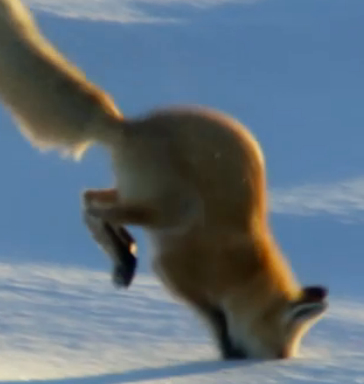An Inordinate Love of Foxes?
Video Illustrates the Wonders of Nature and Teaches Us a Lesson About Our EM World
January 7, 2014
When asked what he had learned about God from his studies of evolutionary biology, J.B.S. Haldane replied that the Creator has “an inordinate fondness of beetles” — after all, there are 400,000 different species of beetles and only 8,000 species of mammals. Take a look at this video and you might wonder whether red foxes are another of God’s favorite creatures. (Be sure to watch the clip in full screen mode.)
The red fox hunts by jumping up in the air and diving for its prey.
As the narrator tells us, the fox can locate a mouse even when hidden under a deep pile of snow. It’s tempting to attribute a fox’s success to a keen sense of hearing or smell, but it turns out to be more complicated than that. A German-Czech team of researchers has found that red foxes have an added advantage: They can use the Earth’s magnetic field to home in on their target.
After recording 592 different jumps, the researchers could see that the foxes had a clear preference —the North-South axis— in how they position themselves before leaping into the air. A statistical analysis shows that the odds that their orientation was random are so small that it is virtually certain that the foxes’ behavior does not happen by chance. When there was little or no snow or vegetation cover—that is, when the prey was out in the open— the fox has no need to access the Earth’s magnetic field and showed no preferred direction for those jumps. The researchers deduced that the Earth’s invisible field was guiding the foxes in the snow.
When a fox is pointing —generally— towards the northeast, it has a remarkable rate of success: a meal in nearly three out of every four jumps. In contrast, when pointing in most other directions, the fox goes hungry more than 80% of the time.
Team leaders Jaroslav Cerveny of the Czech University of Life Sciences in Prague and Hynek Burda and Sabine Begall of Germany’s University of Duisburg-Essen attribute the “dramatic increase” in the foxes’ success to their use of a “magnetic compass” to estimate its distance from the prey. Their findings are presented in Biology Letters, a journal of the U.K.’s Royal Society. The paper was published in 2011 and is open access.
A Talent Shared by Fish, Birds, Rats and Cows
Members of the same team have documented a magnetic sense in many different animals — exercised often without any obvious reason. They call it “spontaneous, non-goal-directed orientation” to the magnetic field and they’ve seen it in carp, in mole rats, and in cattle and deer.
And just a few days ago, they reported that dogs have a preferred orientation when defecating. A survey of 37 breeds showed that males and females favor a North-South axis and avoid East-West. Unlike the case of the red foxes, the researchers offer no obvious reason for the dogs’ preference; they call it “enigmatic.” (This has gotten a lot of press, for instance, here’s the Los Angeles Times coverage.)
The same team found additional support for the role of magnetic fields: EMFs from high-voltage power lines disrupt the alignment of the cows and deer. The researchers saw no preferred direction among cows for a distance of up to 150 meters from a power line. The “disturbing effect of the ELF MFs on body alignment diminished with distance from [the lines],” they reported in the highly regarded Proceedings of the National Academy of Sciences.
Similarly, the defecating dogs lose their preference for the North-South axis when there are variations in the local direction of the Earth’s magnetic field.
Many other species, especially birds, have long been known to use a magnetic compass for navigation. (See this review by two pioneers in the field.) What’s still mysterious is how they can do it. Various mechanisms have been proposed— based on magnetite, radical pair recombination and ion cyclotron resonance— yet a satisfying explanation remains elusive.
The important point seems to get lost: The fact that they can do it at all. The prevailing dogma remains that what we are seeing is anomalous — these effects are not real. Can’t we finally admit that they do exist?
Easier said than done. Sensitivity to weak electromagnetic field lies at the heart of the old thermal/non-thermal chestnut. The fox challenges the thermal paradigm, by being able to extract information from small changes in the local field. Whatever is going on has nothing to do with heating. The thermalists would have us believe that this amazing, unexplained talent is fanciful, at best. Saying otherwise would open up a Pandora’s box of health and safety concerns.
Read more at

No comments:
Post a Comment